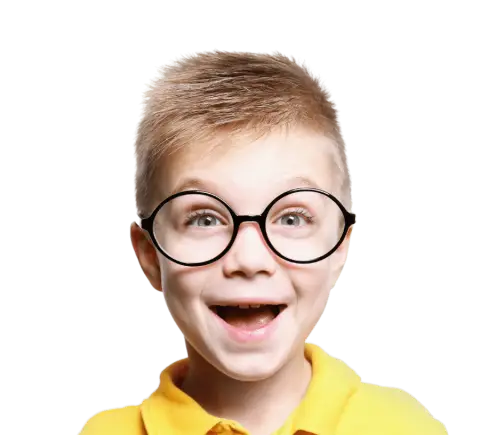Congenital cataract
Contrary to popular belief that cataracts only occur in older people, children and babies can be born with cataracts or develop them in childhood. Congenital cataracts cause the same symptoms as cataracts in adults – fogging and turbidity in the lens of the eye that lead to blurred vision or blindness in severe cases. The lens of the eye is located behind the pupil, it is transparent in its natural state and allows light to penetrate and focus on the retina. When a cataract develops, the lens becomes cloudy and cloudy, the light cannot focus and the resulting image is blurred and distorted.

For more information and to schedule a consultation call:
Or leave details and we will get back to you as soon as possible
How does our eye work?
When light enters our eye it is focused first by the cornea (transparent layer at the front of the eye) and then more precisely by the lens, so that it is optimally focused on the retina.
The refraction and focus of light by the cornea and lens help make vision clear and sharp.
The retina is the back layer of the eye, sensitive to light and converts it into electrical signals that travel along the optic nerve towards the brain.
The brain interprets these signals and creates the final image we see.
When a baby is born, the eyes and brain learn to work together, and the connection between them is known as the visual pathway.
This track develops throughout childhood and up to the age of 7-8.
During this period it is important that the eyes send a clear and constant image to the brain.
The most important time for the development of the visual pathway is the first 2-4 months of life – if the eyes do not send the brain a clear image during this period of time, the brain may never learn to see clearly. After the age of eight, the visual pathways and the parts of the brain responsible for vision finish being fully formed and are difficult to change after that.
Therefore, it is important to treat vision problems before this age, preferably as early as possible.
If a child suffers from an eye condition that affects vision, such as a congenital cataract, the visual system will not develop properly and this is because a cataract affects the amount of visual stimulation that the eye sends to the brain.
What is a congenital cataract?
Contrary to popular belief that cataracts only occur in older people, children and babies can be born with cataracts or develop them in childhood.
Congenital cataracts cause the same symptoms as cataracts in adults – fogging and turbidity in the lens of the eye that lead to blurred vision or blindness in severe cases. The lens of the eye is located behind the pupil, it is transparent in its natural state and allows light to penetrate and focus on the retina.
When a cataract develops, the lens becomes cloudy and cloudy, the light cannot focus and the resulting image is blurred and distorted.
What are the symptoms of congenital cataract?
Cataracts are not always visible, and the symptoms can vary according to the age of the child.
If the child is mature enough, he can complain of visual symptoms such as: cloudy vision, blurred vision, decreased vision, double vision, sensitivity to bright lights or colors that appear faded.
If the child’s age is younger and he cannot complain, other clues can be used that can indicate a cataract, such as a white or gray spot on the pupil.
Also, when illuminating with a flashlight – there should normally be a reflection of red light from both eyes.
If this light reflection is damaged and the pupils appear white instead of red, this can indicate a cataract, although there are other conditions that can cause this sign.
It is important to remember that cataracts can appear in only one eye.
The presence of cataracts can also be suspected based on the child’s behavior patterns, for example when the child does not look directly at faces or other objects.
They may also squint and shield their eyes when exposed to bright sunlight.
Also in pictures – the eyes can appear white instead of red (because of the specified light reflection).
If it is suspected that the child is suffering from cataracts, the pediatrician should be contacted as soon as possible to send for an eye examination, as early treatment can prevent long-term vision complications, which may be irreversible.
What are the causes of congenital cataracts?
Cataracts are not always visible, and the symptoms can vary according to the age of the child.
If the child is mature enough, he can complain of visual symptoms such as:
Cloudy vision, blurred vision, decreased vision, double vision, sensitivity to bright lights or colors that appear faded.
If the child’s age is younger and he cannot complain, other clues can be used that can indicate a cataract, such as a white or gray spot on the pupil.
Also, when illuminating with a flashlight – there should normally be a reflection of red light from both eyes.
If this light reflection is damaged and the pupils appear white instead of red, this can indicate a cataract, although there are other conditions that can cause this sign.
It is important to remember that cataracts can appear in only one eye.
The presence of cataracts can also be suspected based on the child’s behavior patterns, for example when the child does not look directly at faces or other objects.
They may also squint and shield their eyes when exposed to bright sunlight.
Also in pictures – the eyes can appear white instead of red (because of the specified light reflection).
If it is suspected that the child is suffering from cataracts, the pediatrician should be contacted as soon as possible to send for an eye examination, as early treatment can prevent long-term vision complications, which may be irreversible.
Congenital cataract diagnosis
Most congenital cataracts are detected shortly after birth when the baby is examined before leaving the hospital.
Some of them are identified by the pediatrician during the routine examinations, and sometimes due to the suspicion of the parents when the child is very sensitive to bright lights or when it seems that it is difficult to focus.
After the suspicion has been raised, the child will be sent for a thorough eye examination which will include a slit lamp examination in both eyes, an intraocular pressure (IOP) test and other routine tests.
Congenital cataract treatment
Treatment for congenital cataracts varies depending on the type and severity of the cataract, but in most cases surgery will be required to remove it as early as possible, as early as a few weeks of age.
Children who undergo cataract surgery usually experience very little pain or discomfort and the operation is performed under general anesthesia.
In the first step, the lens is broken into small pieces with a special device, and these pieces are removed through a small opening in the cornea.
Complications that may occur, although rare, include glaucoma, retinal detachment, infection, or the need for additional surgery.
After the surgery, it is necessary to restore the eyes in order to repair and restore the connections between the eyes and the brain, which are necessary for clear vision.
One of the risks of late cataract repair is the development of a lazy eye, then it may be necessary to cover the good eye after cataract surgery in order to stimulate and encourage vision in the eye that has not received enough visual stimulation.

